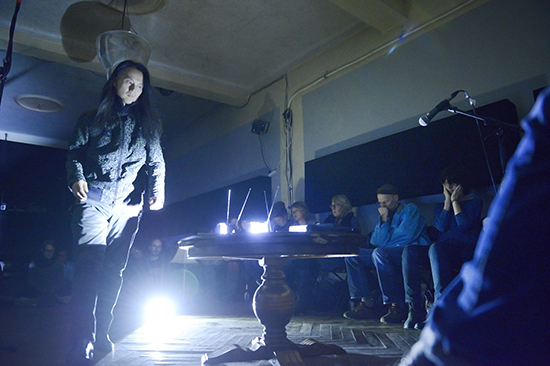 |
Aki Onda, Radio Revolten photo Marcus Andreas Mohr |
"…radioart cannot remain in the field of ‘aesthetics’ any more. It has to be involved in ecology, micro-politics and philosophy of technology, too." Tetsuo Kogawa, Radio Revolten Pre-Manifest
Medium wave radio in Germany has been vacant for a while. However, in October this abandoned bandwidth was taken up by a temporary station broadcasting from the regional city of Halle. This pop-up station—also on FM—housed in the spiral tower of the vacated Physics Institute invited a question: What if we turn these abandoned analogue frequencies over to artists?
This is a festival that very much happened on the radio, with the installations and performances activated by, and made for, radio and transmission. A once in a decade event, Radio Revolten sidestepped the question of what radio art is to showcase what artists are doing with radio right now, creating a space where artists could experiment together.
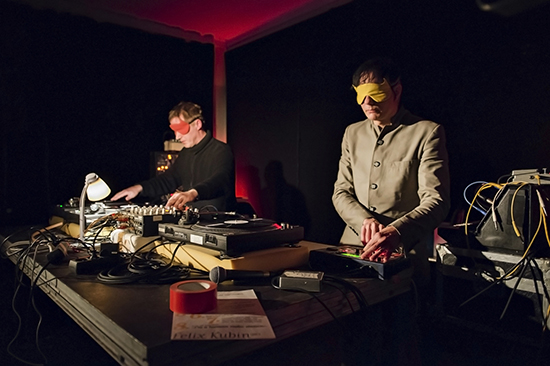 |
Blindfold Babies, Radio Revolten photo Marcus Andreas Mohr |
Headquartered in a previously unoccupied building in the city centre, alongside performance and installation spaces, the broadcast studio set up by local community station Radio Corax was kept available for spontaneous collaboration and as a canvas for experimentation. Curator Sarah Washington explained to me, “We’ve been working for years to try to have radio without a schedule, and we’ve sort of managed it this time.” To achieve a mostly open schedule, she says they had to throw artists in the deep end, but that they appreciated the freedom. Each day’s broadcast is anchored in a program of live performances made for, and sometimes about, radio. Live sound effects with all manner of objects, sophisticated microphony, electromagnetic explorations, blindfolded turntablism, virtuoso vocalities... these performances are as diverse as they are breathtaking.
Aki Onda
Aki Onda walks in slow circles holding a radio. Subtle fluctuations ensue. He plays the space and the spectra within it, fragments of radio voices and the whines and buzzes between, building to a flickering synchronised interference between a strobe light and the radio.
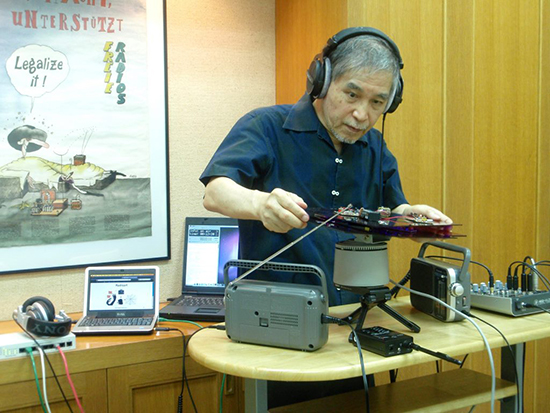 |
Tetsuo Kogawa, Radio Revolten photo courtesy the artist |
Tetsuo Kogawa
Tetsuo Kogawa, pioneer of mini FM, cannot be here in person but sends a single take video of his performance. Four circular coiled antennae dance carefully around each other spinning and intersecting as we listen to the subtle interferences in-between. The crowd knows he’s listening.
Getting physical
After the performances people talk long into the night, converse in shapes on the dance floor, play ping pong in the garden and get to work on shared imaginaries for possible radio futures. Bringing people together is critical to the festival’s mission. Washington explains, "We wanted to make the network physical instead of having [it virtual]. It's important in this day and age, in times of real turbulence in the world, to bring people together.” Artistic director Knut Aufermann adds, "The important thing was to try and get as many people here as possible, to show what they do and to meet and form new alliances, new bonds, new meetings, new ideas.”
Talking community radio
Alongside the artworks, performances and workshops, Revolten hosted two community radio conferences. The overlap of participants in all these events created a fruitful mash-up of politics and aesthetics. A day of presentations of various community radio projects by and with diverse groups of refugees showed innovation and diversity in radio form. Creative re-purposing of digital material alongside terrestrial broadcasting is happening in these multilingual cross-cultural and borderless contexts. This is a deliberate juxtaposition: "Everything we do, every radio project, is about giving people access and that is such a political thing, being in control of your own media, dealing with whatever political regulations there are in the country you are in. The art and the politics for me are completely blended," says Sarah Washington.
Community radio as a generative context for creative approaches to transmission is also articulated by Anna Friz. On a curatorial tour of the exhibition Das Große Rauschen – The Metamorphosis of Radio, Friz observes that many of the artists involved in this “open experiment about a transmission ecology” have their roots in community broadcasting.
I speak with some artists who don't see their work as intrinsically political and some community broadcasters who question aesthetics as a priority. The middle ground is a shared recognition that the freedom to experiment aesthetically is itself political, and can open up new understandings that existing forms and formats might leave closed. Telling diverse stories requires a proliferation of ways of telling.
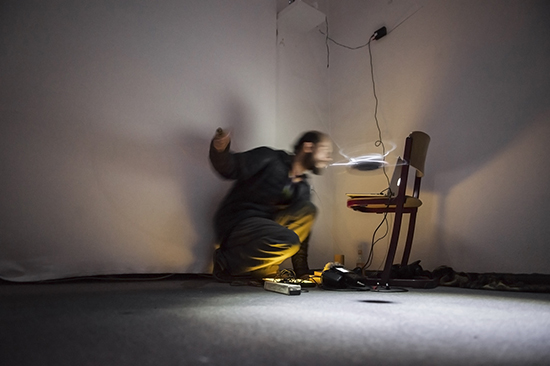 |
Rodrigo Rios Zunino performing with installation 360 for Radio Relay Circus, Radio Revolten photo Marcus-Andreas Mohr |
Fernando Godoy and Rodrigo Rios Zunino, 360°
In a darkened room four small radios hang from the ceiling, dimly lit from above. They spin. Faster and faster. Slower. Almost stopping. Going back the other way. Spinning and spinning. Each receiving as it spins. A crackle, a between signal that is modulated as the antenna rotates, flickers, spins, slows. 360° by Fernando Godoy M and Rodrigo Ríos Zunino rewards sitting for a long time to simply listen, partly because within what appears to be very simple is an endless subtle complexity. It goes around and around but changes all the time. Many small revolutions.
Radio Space is the Place
At the Radio Space is the Place conference organisers keep a couple of seats on the panel open for members of the audience to join in parts of the discussion which explores future radiophonic collectives, alternative spacialisations, politics and poetics of wireless space radio as an experimental laboratory and issues of archiving.
Sally McIntyre and Meredith Kooi both make important contributions related to localised listening and critical spaces of micro-transmission. Sometimes place is the space.
At one point the predictable debate surfaces about whether actual radio waves need to be involved for something to be radio. At this point even analogue radio is highly digitised in its core infrastructure, and the histories of radio and the Internet are closely intertwined. But some are critical of trends towards allowing our listening to be enclosed by podcast subscriptions and curated by playlist algorithms that choose things they expect us to already like.
Amid the collective reflection on filter bubbles following surprises from Trump and Brexit in polls of recent months, the value of listening to things we are not expecting to hear, as a way of better understanding our world, would seem to take on a fresh urgency. Whether digital or analogue, an aesthetics of openness and inclusion is something we need. Throughout the conference Anna Friz keeps bringing us back to this question of listening, and to thinking about listeners.
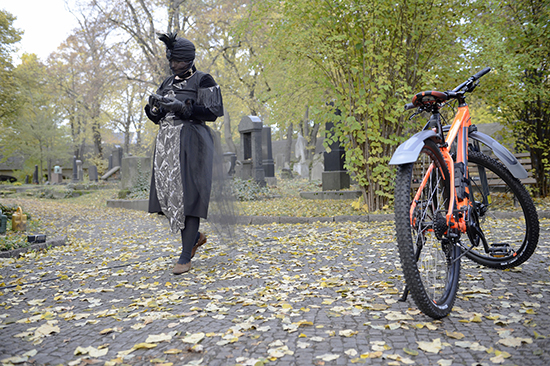 |
Sweet Tribology, Julia Drouhin, Radio Revolten photo Marcus-Andreas Mohr |
Julia Drouhin
Julia Drouhin (AU/FR), dramatically veiled in black lace among the mossy
tombstones of Halle’s Renaissance cemetery, performs something ephemeral and edible. This French-Tasmanian artist, who has featured on ABC Radio’s Soundproof, is known for making records out of chocolate. A delicate process of casting confectionery in state of the art silicone reproduces the grooves with surprising fidelity. The sounds are as good as they taste and can be played for a little while before disintegrating. Some of the records break coming out of the moulds and are distributed to the crowd for consumption without ever being heard. I am surprised by how this brings the crowd together, like a strange sweet communion. Small radios across the cemetery play a broadcast backdrop composed of works by 40 women who collaborated on the project, their creations printed to vinyl disks from which Drouhin's confections were also cast.
Australia’s Soundproof: achievement and erasure
With her usual skill in inviting us to follow our ears, Miyuki Jokiranta, producer and presenter of Soundproof, Australia's internationally acclaimed creative radio and sound art program, presented a showcase of Australian creative radio delivered on Radio Revolten Radio.
The very recent news that Soundproof will be decommissioned by the ABC leaves us with fewer surprises ahead and less chance of turning the dial to that unanticipated sound that catches our ear and stretches our imagination in new directions. Radio Revolten gathered many international artists who have graced Soundproof's airwaves, so this news comes as a particular shock on the back of such an extraordinarily inspiring and affirming event.
Radio Revolten's Artistic Director Knut Auferman said, "At a time where the international art world's curiosity about radio as artistic material is constantly rising [...] this decision smacks of shortsightedness and parochialism. It takes years to build up the expertise to produce program strands like Soundproof, and seconds to axe them" And Gregory Whitehead, who has worked closely with different iterations of the ABC's creative programming over several decades, commented, "In a very short period of time, Soundproof has become internationally respected for encouraging a beautifully polyphonous diversity of storytelling, in every dimension. To pull the plug now, reveals a massively self-defeating narrowness of mind and spirit. Soundproof is a program that speaks for the infinite possibilities of the human imagination in the world of words, music and sound. Killing such a program in its infancy reveals a toxic corporate mindset that rips out the garden for yet another parking lot."
The national broadcaster has systematically gutted the local ecosystem for creative radio with the decommissioning of more than six programs in the last two years that used to support Australian artists. Now it has laid out its plans to wind Radio National down completely over the next few years as it abandons audiences who listen, to chase audiences who can be counted. The ABC touts the move to more talk as a way to lead the national conversation. Talk is not conversation. If we want new listening experiences, we must make them ourselves and find new forms and platforms for sharing them.
When RN is done with medium wave, then maybe it will be time to give the frequency back to artists...we are not short of ideas for what do with it.
Go to Radio Revolten
Missed the revolution? Head over to the Radio Revolten archives for extensive audio, photos and the daily reflections of Revolten’s official diarist Gabi Schaffner throughout the month.
Radio Revolten International Radio Art Festival, Halle, Germany, 1-30 Oct
RealTime issue #135 Oct-Nov 2016 pg.
© Sophea Lerner; for permission to reproduce apply to [email protected]








 back
back